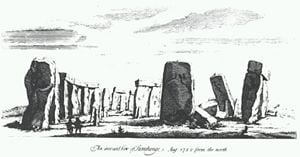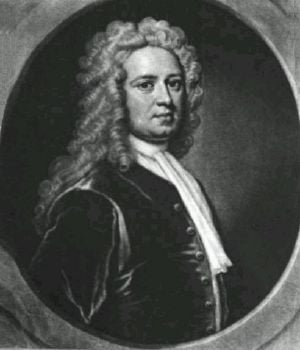Stukeley, William
| Line 53: | Line 53: | ||
* Gjertsen, Derek. ''The Newton Handbook.'' London: Routledge & Kegan Paul, 1986. ISBN 0710202792 | * Gjertsen, Derek. ''The Newton Handbook.'' London: Routledge & Kegan Paul, 1986. ISBN 0710202792 | ||
* Haycock, David Boyd. ''William Stukeley: Science, Religion and Archaeology in Eighteenth-century England.'' Boydell Press, 2002. ISBN 0851158641 | * Haycock, David Boyd. ''William Stukeley: Science, Religion and Archaeology in Eighteenth-century England.'' Boydell Press, 2002. ISBN 0851158641 | ||
| + | * Hawkins, Gerald S. ''Stonehenge Decoded.'' Hippocrene Books, 1988. ISBN 978-0880291477 | ||
* Mortimer, Neil. ''Stukeley Illustrated: William Stukeley's Rediscovery of Britain's Ancient Sites.'' Green Magic, 2003. ISBN 0954296338 | * Mortimer, Neil. ''Stukeley Illustrated: William Stukeley's Rediscovery of Britain's Ancient Sites.'' Green Magic, 2003. ISBN 0954296338 | ||
* Piggot, Stuart. ''William Stukeley: An Eighteenth-Century Antiquary.'' New York, NY: Thames and Hudson, 1985. ISBN 0500013608 | * Piggot, Stuart. ''William Stukeley: An Eighteenth-Century Antiquary.'' New York, NY: Thames and Hudson, 1985. ISBN 0500013608 | ||
Revision as of 20:52, 7 May 2008
The Rev. Dr William Stukeley FRS, FRCP, FSA (November 7, 1687 – March 3, 1765) was an English antiquary who pioneered the archaeological investigation of Stonehenge and Avebury and was one of the founders of field archaeology. Stukeley also was one of the first biographers of Isaac Newton.
Life and work
William Stukeley was born the son of a lawyer at Holbeach in Lincolnshire on the site of Stukeley Hall, a primary school that now bears his name. After taking his M.B. degree at Corpus Christi College, Cambridge, Stukeley went to London and studied medicine at St Thomas' Hospital. In 1710, he started in practice in Boston, Lincolnshire, returning in 1717 to London. In the same year, he became a Fellow of the Royal Society and, in 1718, joined in the establishment of the Society of Antiquaries, acting for nine years as its secretary. In 1719 Stukeley took his M.D. degree, and in 1720 became a Fellow of the Royal College of Physicians, publishing in the same year his first contribution to antiquarian literature.
Stukeley was one of the first learned gentlemen to be attracted to speculative freemasonry, newly fashionable after the appointment of the first noble Grand Master. His Diary and Commonplace Book of June 6, 1721 says "I was made a Freemason at the Salutation Tav., Tavistock Street, with Mr. Collins, Capt. Rowe, who made the famous diving Engine."[1] The same entry says he was the first person for many years who had been so made in London; there was great difficulty in finding sufficient members to perform the Ceremony; and immediately thereafter "Freemasonry took a run and ran itself out of breath through the folly of its members."
His diary and papers are among the earliest sources on the subject of the new Grand Lodge.

Stukeley's principal works, elaborate accounts of Stonehenge and Avebury, appeared in 1740 and 1743. These were supposed to be the first of a multi-volume universal history. Stukeley proposed that an ancient patriarchial religion was the original religion of mankind. This had subsequently degenerated as idol-worship had emerged. Stukeley believed that the Druids and the early Christians were examples of this religion. Stukeley himself was a Protestant. (Source: Stonehenge, a Temple Restor'd, by Stukeley).
Stukeley's work on Stonehenge was one of the first to attempt to date the monument.[3] He proposed that the builders of Stonehenge knew about magnetism, and had aligned the monument with magnetic north. Stukeley used some incomplete data about the variation of the North Magnetic Pole; he extrapolated that it oscillated in a regular pattern. Today it is known that the North Magnetic Pole wanders in an irregular fashion. However, Stukeley inferred that Stonehenge was completed in 460 B.C.E., which as we now know is several thousand years too late.
He wrote copiously on other supposed Druid remains, becoming familiarly known as the "Arch-Druid." In 1729 he took holy orders, and, went on to hold two livings in Lincolnshire, including that of the parish of All Saints, Stamford, Lincolnshire, where he did a considerable amount of further research, not least on the town's lost Eleanor Cross. He was subsequently appointed rector of a parish in Bloomsbury, London. He died in London on 3 March 1765.
In 1742 he visited the Royston Cave at Royston, Hertfordshire and a year later he published his Palaeographia Britannica or discourses on Antiquities in Britain no.I, Origines Roystonianae, or an account of the Oratory of lady Roisia, Foundress of Royston discovered in Royston in August 1742. Following a response by the Reverend Charles Parkin he penned the sequel: Palaeographia Britannica or discourses on Antiquities in Britain no.II, or defense of Lady de Vere, Foundress of Roiston, against the Calumny of Mr. Parkin, rector of Oxburgh wherein his pretended answer is fully refuted: the former opinion further confirm'd and illustrated. To which are occasionally added, many curios matters in antiquity.
Stukeley was a friend of Isaac Newton and wrote a memoir of his life (1752).
Quotes
- Our predecessors, the Druids of Britain, tho' left in the extremest west to the improvement of their own thoughts, yet advanc'd their inquiries, under all disadvantages, to such heights, as should make our moderns asham'd, to wink in the sunshine of learning and religion.
- Stonehenge: A Temple Restor'd to the British Druids, Preface. (1740)
- This mighty wall of four score miles in length is only exceeded by the Chinese wall, which makes a considerable figure upon the terrestrial globe, and may be discerned at the moon.
- Private letter published in The Family Memoirs of the Rev. William Stukeley (1887) Vol. 3, p. 142. (1754)
Publications
- Stukeley, William. Stonehenge, a Temple Restor'd to the British Druids. Forgotten Books, 2007 (original 1740).
- Stukeley, William. Abury, a Temple of the British Druids. 1743.
- Stukeley, William. The Philosophy of Earthquakes, Natural and Religious, Or, An Inquiry Into their Cause and their Purpose London: C. Corbet, 1750.
- Stukeley, William. Memoirs of Sir Isaac Newton's Life . . . 1752: Being Some Account of his Family and Chiefly of the Junior Part of his Life. Taylor and Francis, 1936 (original 1752).
- Stukeley, William. Itinerarium curiosum: Or, An account of the antiquities, and remarkable curiosities in nature or art, observed in travels through Great Britain, 2nd ed. Republished Gregg, 1969 (original 1724). ISBN 978-0576193122
- Stukeley, William and Roger Gale. The Family Memoirs Of The Rev. William Stukeley And The Antiquarian And Other Correspondence. Kessinger Publishing, 2007 (original 1754). ISBN 978-0548190098
Notes
- ↑ Stukeley, William (1980). The Commentarys, Diary, & Common-Place Book of William Stukeley & Selected Letters. London: Doppler Press, 54.
- ↑ Stukeley, William (1740). Stonehenge, A Temple Restor'd to the British Druids. London: W. Innnys and R. Maney.
- ↑ Hawkins, Gerald S. (1965). Stonehenge Decoded.
ReferencesISBN links support NWE through referral fees
- Burl, Aubrey. Rings of Stone: The Prehistoric Stone Circles of Britain and Ireland. The Harvill Press, 1999. ISBN 978-1860466618
- Burl, Aubrey and Neil Mortimer (eds). Stukeley's Stonehenge: An Unpublished Manuscript 1721-1724. New Haven, CT: Yale University Press, 2005. SBN 0300098952
- Gjertsen, Derek. The Newton Handbook. London: Routledge & Kegan Paul, 1986. ISBN 0710202792
- Haycock, David Boyd. William Stukeley: Science, Religion and Archaeology in Eighteenth-century England. Boydell Press, 2002. ISBN 0851158641
- Hawkins, Gerald S. Stonehenge Decoded. Hippocrene Books, 1988. ISBN 978-0880291477
- Mortimer, Neil. Stukeley Illustrated: William Stukeley's Rediscovery of Britain's Ancient Sites. Green Magic, 2003. ISBN 0954296338
- Piggot, Stuart. William Stukeley: An Eighteenth-Century Antiquary. New York, NY: Thames and Hudson, 1985. ISBN 0500013608
External links
- Text and engravings of Stukeley's Avebury survey online
- Bronze Medal of William Stukeley at the British Museum
- William Stukeley (1687 - 1765)
Credits
New World Encyclopedia writers and editors rewrote and completed the Wikipedia article in accordance with New World Encyclopedia standards. This article abides by terms of the Creative Commons CC-by-sa 3.0 License (CC-by-sa), which may be used and disseminated with proper attribution. Credit is due under the terms of this license that can reference both the New World Encyclopedia contributors and the selfless volunteer contributors of the Wikimedia Foundation. To cite this article click here for a list of acceptable citing formats.The history of earlier contributions by wikipedians is accessible to researchers here:
The history of this article since it was imported to New World Encyclopedia:
Note: Some restrictions may apply to use of individual images which are separately licensed.

